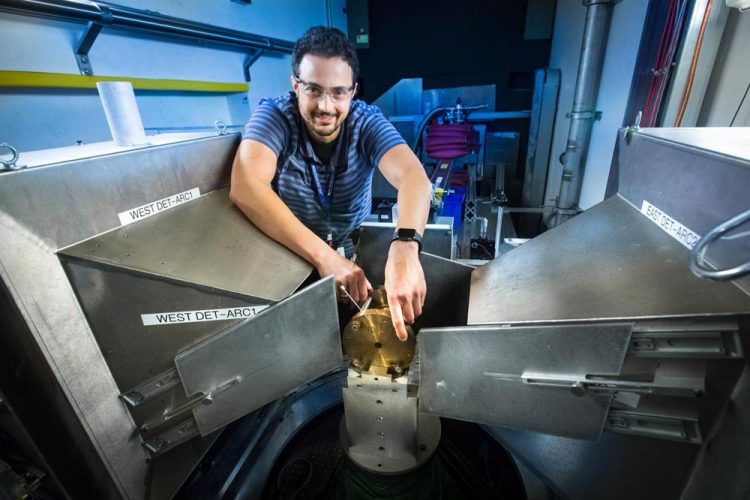Neutron diffraction probes forms of carbon dioxide in extreme environments

Adam Makhluf from the University of California, Los Angeles is using neutrons at Oak Ridge National Laboratory's Spallation Neutron Source to study the fundamental role carbon dioxide plays in Earth's carbon cycle, especially in the composition of carbon reservoirs in the deep earth and the evolution of the carbon cycle over time. Credit: Genevieve Martin/ORNL
Through a Deep Carbon Observatory collaboration, Adam Makhluf of the University of California, Los Angeles's Earth, Space and Planetary Science Department and Chris Tulk of Oak Ridge National Laboratory's Chemical and Engineering Materials Division are using neutrons to study the fundamental role carbon dioxide plays in Earth's carbon cycle, especially in the composition of carbon reservoirs in the deep earth and the evolution of the carbon cycle over time.
Makhluf and Tulk are using the SNAP instrument, SNS beam line 3, located at ORNL's Spallation Neutron Source, to provide insight into carbon dioxide's behavior under intense conditions.
“At high pressures and temperatures, it is thought that carbon dioxide can take on unusual bonding arrangements that make it very similar chemically to silicon dioxide,” Makhluf said. “There may be much more carbon than we think inside of the Earth because of substitution reactions with the most ubiquitous oxide on earth, silicon dioxide.”
Studying such specific aspects requires very small samples that can be put under extreme high pressure, a process possible with an apparatus called a diamond anvil cell. This cell pressurizes the sample between two diamonds and allows researchers to place the sample in the neutron beam to produce crystallographic data. Although this high pressure is necessary to analyze the carbon dioxide, high temperatures are also essential to fully interpret the results.
“No one has ever laser heated such a large sample under high pressure,” Makhluf said. “This study is meant to advance neutron science in diamond anvil cells so that other users can investigate samples at extreme temperatures.”
ORNL neutron diffraction experts Reinhard Boehler and Tulk, a SNAP instrument scientist, are important contributors to this technique.
Carbon dioxide is versatile, adapting and producing new forms depending on the pressure and temperature levels. In fact, the carbon dioxide phase known as CO2-V typically emerges under harsh conditions, providing a way to effectively study Earth's mantle.
Despite carbon's notable influence on crucial planetary functions, scientists do not yet understand the details of the high pressure and temperature phases. Some phases are stable as long as they are not subjected to significant disruptions. For example, phase V of carbon dioxide remains metastable even in environments that do not meet the synthesis conditions.
Increasing knowledge about these forms will solidify understanding of carbon interactions in the Earth, providing a foundation on which to base future observations and discoveries.
###
The Deep Carbon Observatory is funded by the Sloan Foundation as a decadal program. SNS is a Department of Energy Office of Science User Facility. UT-Battelle manages ORNL for the DOE's Office of Science. The Office of Science is the single largest supporter of basic research in the physical sciences in the United States, and is working to address some of the most pressing challenges of our time. For more information, please visit http://science.
Media Contact
All latest news from the category: Earth Sciences
Earth Sciences (also referred to as Geosciences), which deals with basic issues surrounding our planet, plays a vital role in the area of energy and raw materials supply.
Earth Sciences comprises subjects such as geology, geography, geological informatics, paleontology, mineralogy, petrography, crystallography, geophysics, geodesy, glaciology, cartography, photogrammetry, meteorology and seismology, early-warning systems, earthquake research and polar research.
Newest articles

Hyperspectral imaging lidar system achieves remote plastic identification
New technology could remotely identify various types of plastics, offering a valuable tool for future monitoring and analysis of oceanic plastic pollution. Researchers have developed a new hyperspectral Raman imaging…

SwRI awarded $26 million to develop NOAA magnetometers
SW-MAG data will help NOAA predict, mitigate the effects of space weather. NASA and the National Oceanic and Atmospheric Administration (NOAA) recently awarded Southwest Research Institute a $26 million contract…

Protein that helps cancer cells dodge CAR T cell therapy
Discovery could lead to new treatments for blood cancer patients currently facing limited options. Scientists at City of Hope®, one of the largest and most advanced cancer research and treatment…



